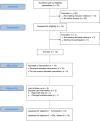Impact of Somatic Yoga and Meditation on Fall Risk, Function, and Quality of Life for Chemotherapy-Induced Peripheral Neuropathy Syndrome in Cancer Survivors
- PMID: 31131640
- PMCID: PMC6537287
- DOI: 10.1177/1534735419850627
Impact of Somatic Yoga and Meditation on Fall Risk, Function, and Quality of Life for Chemotherapy-Induced Peripheral Neuropathy Syndrome in Cancer Survivors
Abstract
Objective: Chemotherapy-induced peripheral neuropathy (CIPN) syndrome causes significant pain as an adverse effect of treatment, with few nonpharmacological interventions tested. A somatic yoga and meditation (SYM) intervention on functional outcomes and quality of life (QOL) was investigated.
Design and methods: Individuals diagnosed with CIPN were enrolled in an open-label, single-arm, mixed-methods feasibility trial.
Participants and setting: In an outpatient rehabilitation center, ten participants with median age 64.4 years (47-81) attended 61% of the sessions with no adverse events.
Intervention: SYM twice a week for 8 weeks for 1.5 hours, with home program and journaling.
Main outcome measures: Primary functional outcomes included Sit and Reach (SR), Functional Reach (FR), and Timed Up and Go (TUG). Self-reported Patient Neurotoxicity Questionnaire (PNQ) and Functional Assessment of Cancer Therapy-Neurotoxicity (FACT-GOG-NTX) were secondary CIPN outcomes. Biomarkers included salivary cortisol (stress) and bioesthesiometer (vibration).
Results: Quantitative findings. Significant improvements were found in flexibility (SR; P = .006); balance (FR; P = .001) and fall risk (TUG; P = .004). PNQ improved significantly ( P = .003) with other measures improving non-significantly. Qualitative findings. Five themes emerged: (1) vacillation of CIPN pain perception over time; (2) transferability of skills to daily activities; (3) improvement in physical function; (4) perceived relaxation as an effect of SYM; and (5) group engagement provided a social context for not feeling isolated with CIPN.
Conclusion: Preliminary data suggest SYM may improve QOL, flexibility, and balance in cancer survivors with CIPN, with a fully powered randomized controlled trial indicated.
Trial registration: NCT03786055.
Keywords: cancer survivorship; fall risk; function; neuropathy; quality of life; somatic yoga.
Conflict of interest statement
Figures
Similar articles
-
Effectiveness of Somatic Yoga and Meditation: A Pilot Study in a Multicultural Cancer Survivor Population with Chemotherapy-Induced Peripheral Neuropathy.Int J Yoga Therap. 2020 Jan 1;30(1):49-61. doi: 10.17761/2020-D-18-00030. Int J Yoga Therap. 2020. PMID: 31483689
-
Yoga for cancer survivors with chemotherapy-induced peripheral neuropathy: Health-related quality of life outcomes.Cancer Med. 2021 Aug;10(16):5456-5465. doi: 10.1002/cam4.4098. Epub 2021 Jul 2. Cancer Med. 2021. PMID: 34213086 Free PMC article. Clinical Trial.
-
Acupuncture for Chemotherapy-Induced Peripheral Neuropathy in Breast Cancer Survivors: A Randomized Controlled Pilot Trial.Oncologist. 2020 Apr;25(4):310-318. doi: 10.1634/theoncologist.2019-0489. Epub 2019 Oct 14. Oncologist. 2020. PMID: 32297442 Free PMC article. Clinical Trial.
-
The Physical Consequences of Chemotherapy-Induced Peripheral Neuropathy.Curr Oncol Rep. 2020 Apr 22;22(5):50. doi: 10.1007/s11912-020-00903-0. Curr Oncol Rep. 2020. PMID: 32323068 Review.
-
Chronic chemotherapy-induced peripheral neuropathy: living with neuropathy during and after cancer treatments.Ann Palliat Med. 2025 Mar;14(2):196-216. doi: 10.21037/apm-24-154. Ann Palliat Med. 2025. PMID: 40211744 Review.
Cited by
-
The Effects of Yoga on the Mental Health of Individuals With Autoimmune Disorders: A Scoping Review.Cureus. 2025 Jan 19;17(1):e77669. doi: 10.7759/cureus.77669. eCollection 2025 Jan. Cureus. 2025. PMID: 39968418 Free PMC article. Review.
-
The Effect of Exercise on Quality of Life among Patients and Survivors of Breast Cancer: A Systematic Review and Meta-Analysis.Asian Pac J Cancer Prev. 2025 Mar 1;26(3):715-723. doi: 10.31557/APJCP.2025.26.3.715. Asian Pac J Cancer Prev. 2025. PMID: 40156386 Free PMC article.
-
Motor and sensory impairment in survivors of childhood central nervous system (CNS) tumors in the St. Jude Lifetime Cohort (SJLIFE).Cancer Med. 2024 Jul;13(14):e7422. doi: 10.1002/cam4.7422. Cancer Med. 2024. PMID: 39056576 Free PMC article.
-
Effects of Different Exercise Interventions on Quality of Life in Breast Cancer Patients: A Randomized Controlled Trial.Integr Cancer Ther. 2019 Jan-Dec;18:1534735419880598. doi: 10.1177/1534735419880598. Integr Cancer Ther. 2019. PMID: 31625419 Free PMC article. Clinical Trial.
-
Optimising Exercise for Managing Chemotherapy-Induced Peripheral Neuropathy in People Diagnosed with Cancer.Cancers (Basel). 2025 Jul 31;17(15):2533. doi: 10.3390/cancers17152533. Cancers (Basel). 2025. PMID: 40805229 Free PMC article. Review.
References
-
- Wonders KY, Reigle BS, Drury DG. Treatment strategies for chemotherapy-induced peripheral neuropathy: potential role of exercise. Oncol Rev. 2010;4:117-125. doi:10.1007/s12156-010-0044-1 - DOI
Publication types
MeSH terms
Substances
Associated data
LinkOut - more resources
Full Text Sources
Medical
Research Materials


